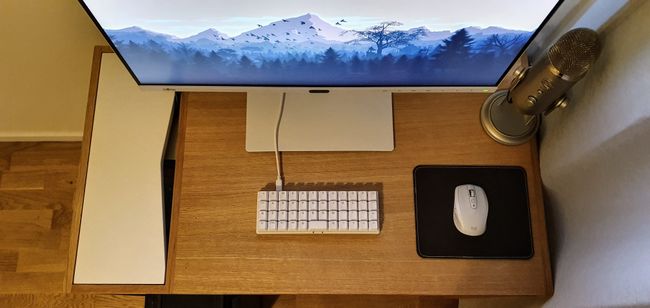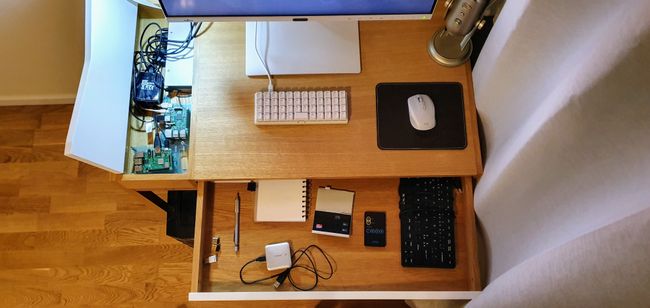My Desktop
Posted December 23, 2019A couple of months ago, I moved to a new apartment, and just this week, I finally got my desktop in place. I got my current desk a couple of weeks ago, but I recently bought a new monitor and wireless mouse, making the arrangement more finished. But who am I kidding — it will never really be finished. I already have plans for upcoming changes.
In this post, I’ll go through my desktop setup. I’ll split it into three categories:
- Desk (monitor, keyboard, mouse, microphone, etc.)
- Hardware (CPU, GPU, motherboard, etc.)
- Software (OS, Window Manager, PDF viewer, etc.)
Desk Setup
My desk setup is:
- Desk: Habitat Greta
- Monitor: Fujitsu P27-8 Te Pro
- Keyboard: Planck EZ
- Mouse: Logitech MX Anywhere 2S
- Microphone: Blue Yeti
Visually, I have stuck to a lot of white following the rest of the room. The desk has two drawers in which I can keep my Raspberry Pis (and related tools), but also paper, SD card collection, USB sticks, etc. I like that I can keep a lot of stuff close while keeping the desk neat and with a minimalistic feeling.
My monitor is a Fujitsu P27-8 Te Pro. It’s a 27” IPS with 2560 x 1440 resolution. I got the monitor (and wireless mouse) last week, so I haven’t thoroughly evaluated and configured them correctly. Although I should say that I’ve never had trouble installing a monitor. I never thought of the process of installing a monitor. Isn’t that just plugging it in? In this case, no. I’m not entirely sure why, but I could not get the monitor working using the DVI cable I used for my previous monitor. It’s a long story, but I finally got it working using HDMI and a mini HDMI adapter. I did not have the time yet to calibrate and evaluate the monitor, but I can say that it’s pretty.
I have used the Planck EZ keyboard for about six months now. It is my first compact keyboard that I use regularly, and I have to admit that I still mistype a lot. I am probably more efficient on a regular-sized keyboard, but I still make progress on my efficiency, so I will keep using it for now. I enjoy the fact that I can customize the firmware myself — the Planck EZ uses an open-source firmware called QMK. You can find my fork of it at Github.
My current primary mouse is a Logitech MX Anywhere 2S. I replaced my previous mouse with it because it’s wireless and white/light grey. Just like the monitor, I have only used it for a couple of days, so I can’t say much about it. The installation was smooth on Arch Linux — I just paired the mouse using bluetoothctl. There is a noticeable input lag, but that is okay for my desktop usage. If I ever feel like gaming, I would switch to my wired Logitech G400. With the new mouse, I also changed mouse pad to a smaller, dark brown, fake leather one. It’s nothing special about it, but it’s a better fit for the desk.
I also have a Blue Yeti Microphone, but I rarely use it. It’s a great microphone though with the only downside that it’s pretty big. Recording with it is a blast. It’s a USB microphone, making it the setup is very easy. It comes with a downside, though, because the USB interface is not excellent for music recording when you want low latency.
Overall, I like my compact workspace with its minimalistic touch. I have been thinking about replacing the computer case with a smaller and white one. Another plan is to rework the cabling for my Raspberry Pis. I could probably make a hole in the back of the desk and get the cables through there. I also need a better chair. But that’s for a future post.
Hardware
- CPU: AMD Ryzen 7 2700X Processor
- GPU: Nvidia GTX 560 Ti / 1GB GDDR5 / ASUS
- Memory: Corsair Vengeance LPX DDR4 3000MHz 16GB
- Motherboard: ROG STRIX X470-F GAMING
- Primary Storage: Intel 660p 512GB M.2 SSD
In short, it’s a pretty fresh and powerful machine, with a slightly old GPU. It suits me very well for now, because I don’t do any gaming, nor any game programming. The most performance heavy task I do is compiling some Yocto images, which is pretty much just lots of compiling. If it wasn’t for the compiling, I could have been efficient enough with my laptop. But it’s very convenient with fast compilation times for whatever programming you do.
My previous workstations have been using Intel CPUs, but this time I thought it was time to start supporting AMD and show appreciation for the fantastic products they deliver. So far I am very happy with my Ryzen 7.
The GTX 560 Ti is from my old rig, but it’s good enough for my current usage. I would prefer a new graphics card with a modern set of connections, but for now, I can manage with the mini HDMI. If I ever want to get into some machine learning, I might think about replacing the Nvidia card. Also, since I’m on Linux, my next graphics card will most likely not be from Nvidia.
Software
- OS: Arch Linux
- Window Manager: bspwm
- Display Manager: None / startx
- Status Bar: polybar
- Terminal Emulator: Termite
- Shell: fish
- Text Editor: neovim
Throughout my childhood, I was a Windows user. My first encountering with Linux was when my father installed a CentOS server in the “computer room” in our basement, which was probably around 2006. A couple of years later I started using Linux a bit myself — my “Welcome to LinuxQuestions.org!” email is from June 2009. I kept a Windows installation for gaming up until recent years. I’ve used Ubuntu, Mint, Elementary OS, and now Arch Linux, which I’ve stuck with for a couple of years. I enjoy Arch, and I feel like there’s not much out there that is worth the change — except my curiosity for trying new stuff, of course.
I use a pretty minimalistic collection of software. To start my system,
I simply login on tty1, which starts a fish shell. Then I type startx
and hit enter, which in initialize using my .xinit.rc with a single line
exec bspwm.
I keep a status bar on the top of the screen. It displays workspace indicators, storage space left, audio volume, free memory, CPU usage, CPU temperature, wifi IP, date, and time. polybar has been working great — it’s very easy-to-use. There are lots of built-in components so that you can get a good result fast.
I should also mention that I use feh to display the background image, and redshift to keep that blue light to a minimum at evening and night.




